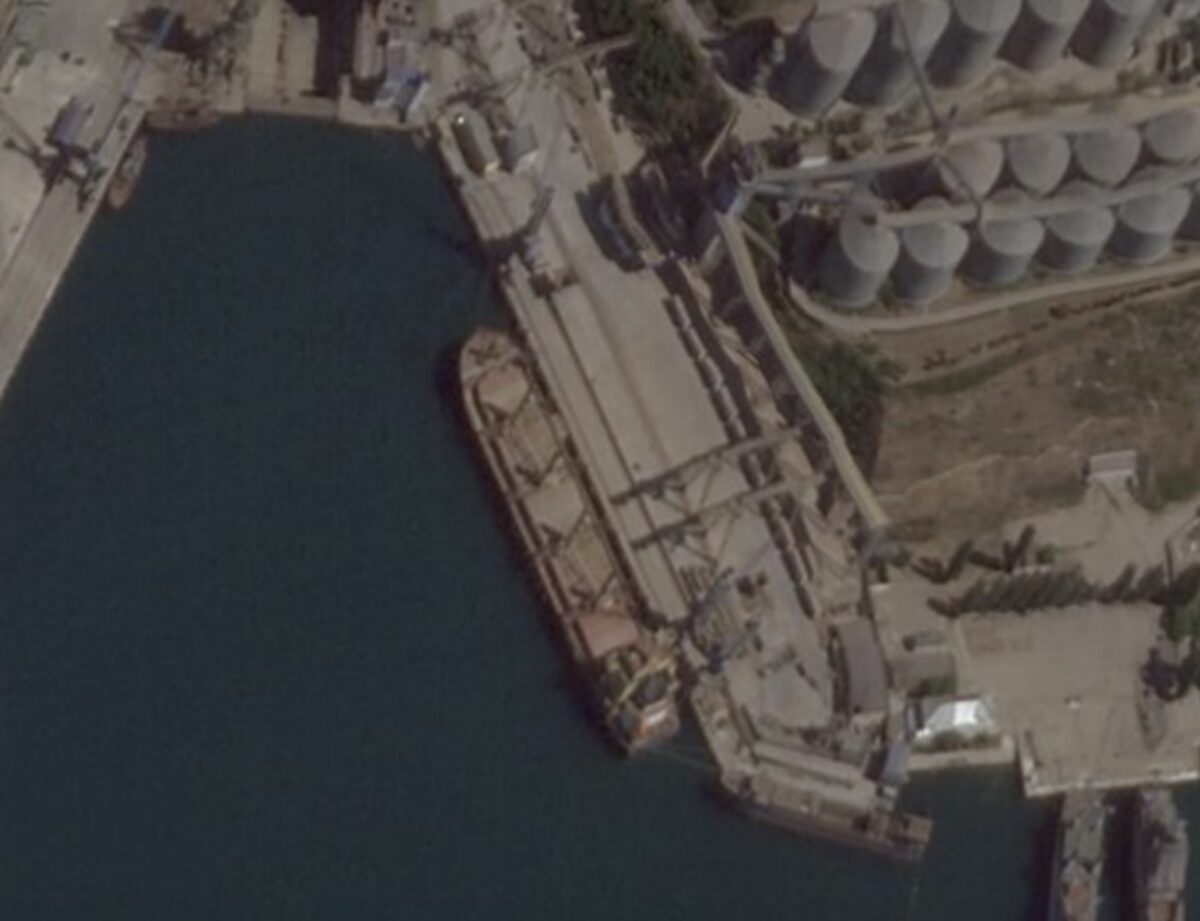Rockets over Yemen: Inside the Houthis’ Botched Attack on Aden Airport
On 30 December 2020, a Yemeni “unity cabinet” arrived at Aden airport. Shortly after they landed, three explosions rocked Aden airport killing at least 22 people, including regular passengers, journalists and aid workers. In an incredible stroke of luck, no members of the cabinet were killed or injured.
The politicians arrived in the port city hoping to heal the divide between the internationally recognised Yemeni government and the Southern Transitional Council (STC). Aboard the plane were politicians from both these groups — a nascent government-to-be and an important outcome of the Riyadh Agreement signed in 2019.
The STC, representing separatist movements in Yemen’s South, was once an ally of the government in its struggle against the Houthi movement. But in 2018, tensions boiled over and the STC seized control of much of South Yemen.
So when these politicians tasked with repairing the rift in the anti-Houthi coalition came under attack, many parties were quick to assign blame. The Houthi movement, also known as Ansar Allah, denied responsibility for the attack, suggesting the STC may have carried it out in an attempt to sabotage the agreement. This was to little avail. On January 11 2021, the US government designated the Houthis as a terrorist organisation, a decision that was later reversed.
The attack on the airport of a busy port city was caught on multiple videos. But so were a number of missile launches from Houthi-held cities to the North-West of Aden — on the very same day. An analysis of open source information from these locations suggests that, despite their denials, the Houthis were most likely responsible for the attack on Aden airport.
The Attack
The attack itself is most clearly portrayed in the video below:
New footage of the missile attack on #adenairport yesterday.#Aden #Yemen pic.twitter.com/y9YxCsa0aI
— Ali Al-Sakani (@Alsakaniali) December 30, 2020
As we can see, three explosions take place over the period of about a minute, all between the plane and the terminal building. The Yemeni Government claimed the attack happened at 13:24, which they supported with footage from CCTV cameras. The earliest identified public reports of this attack having taken place were posted at 13:27 Yemen time, immediately followed by numerous posts reporting the same event.
By examining other videos of the attack it is possible to establish where these missiles exploded in relation to the terminal building and the plane. The exact position of the plane can be established due to the guidance lines marked on the tarmac being visible in both this video and satellite imagery.
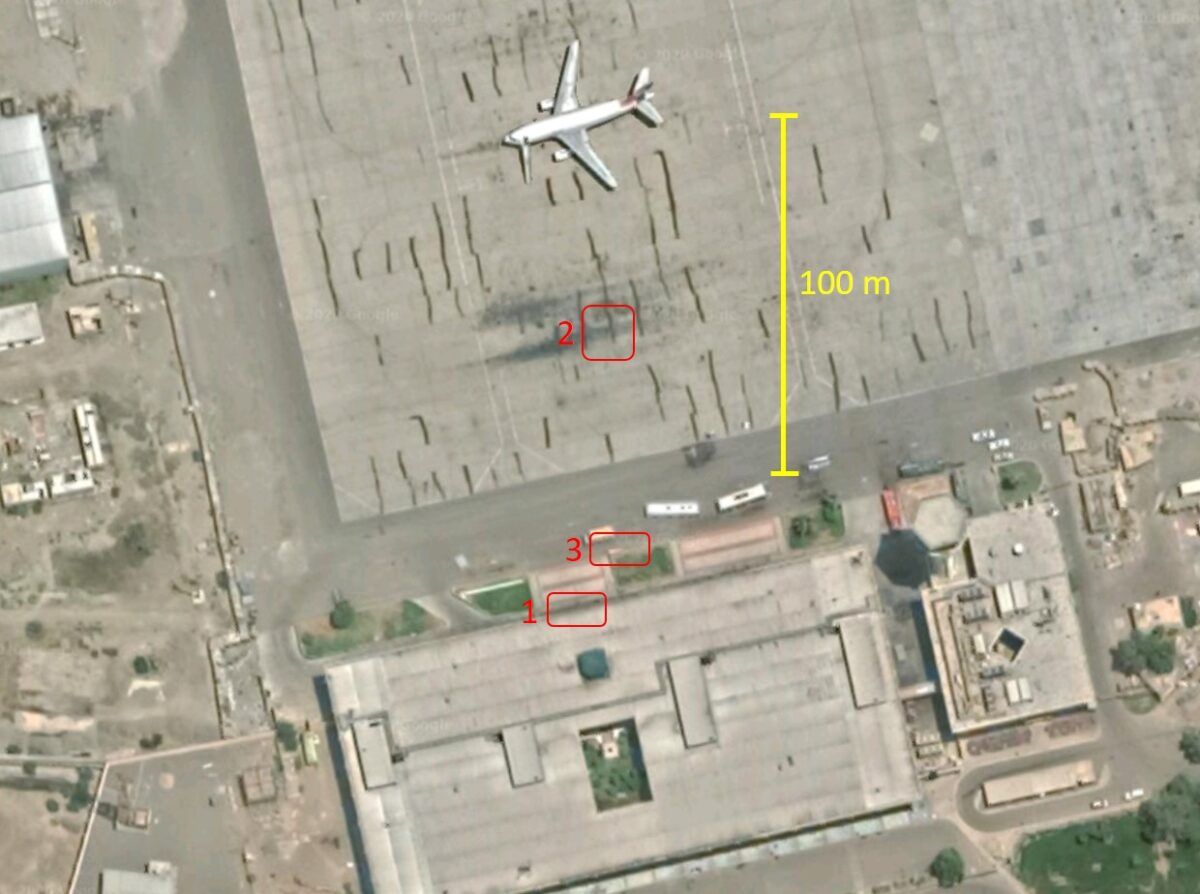
Map of area during attack. Points and order of detonations marked in red. We have edited this satellite image to show the plane’s position (Image: Google/Maxar Technologies)
Of these three explosions, the first detonated several metres up the terminal’s northern wall.
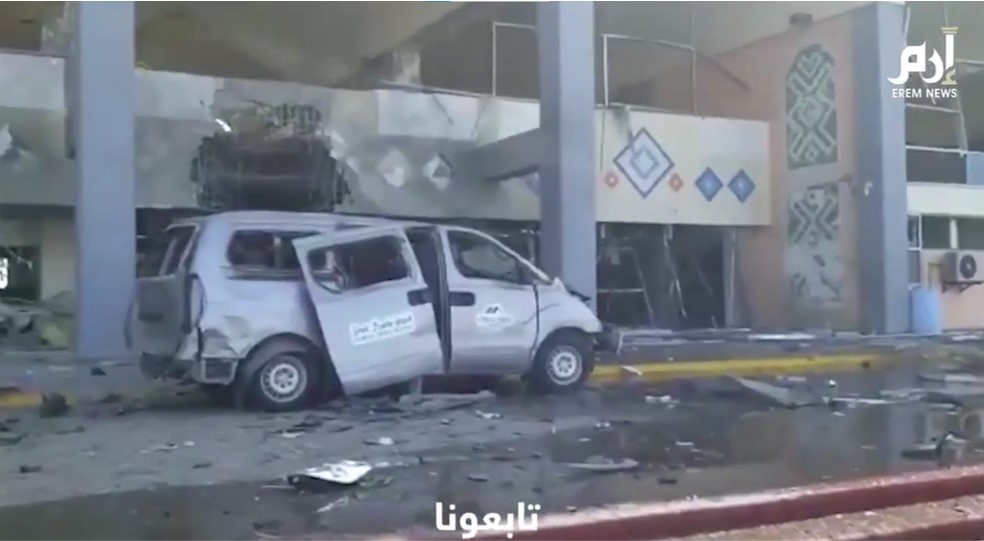
Image: Erem News
The second impacted the tarmac approximately 50 metres away from the plane. Note the presence of a yellow line on the tarmac which shows that this impact hit the parking bay nearest the terminal building.
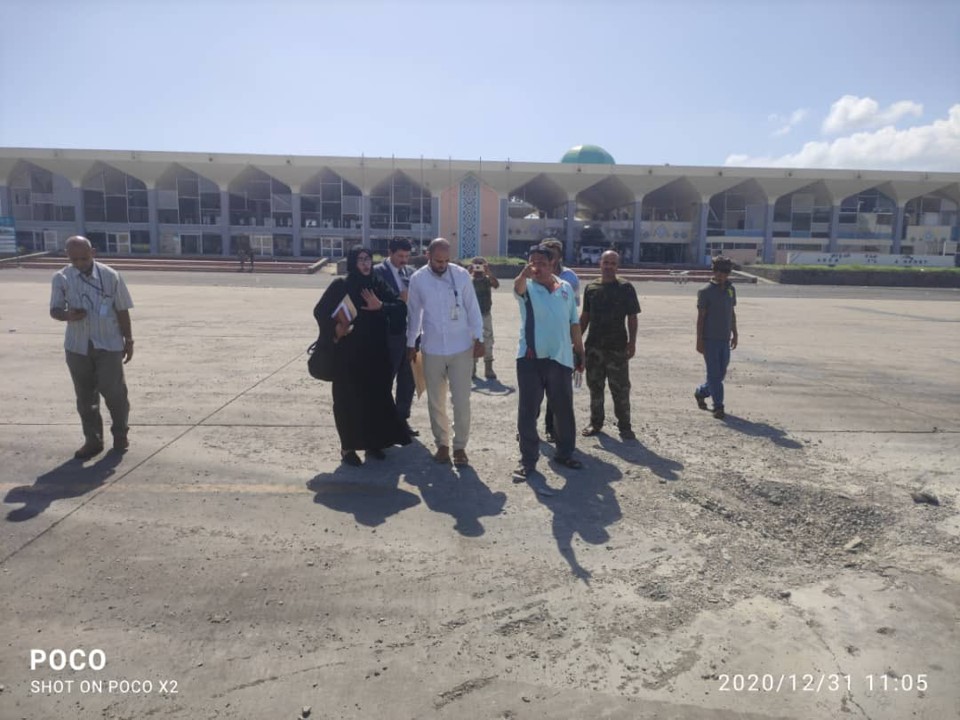
Image: Jouf Now
The third hit a low wall immediately to the North of the terminal.
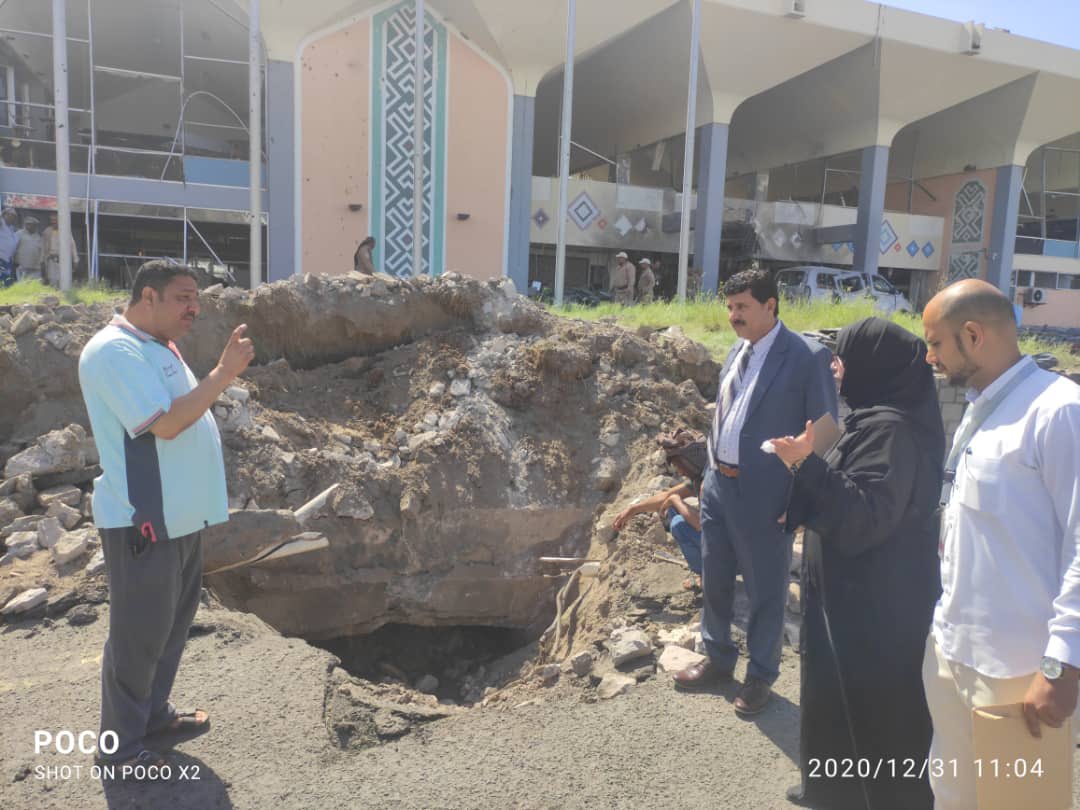
Image: Jouf Now
The location of the second impact is especially important. A journalist from the news website Bawabatii who was present at the airport reported that the plane was supposed to have parked in a different landing bay, but could not due to a large crowd of supporters on the apron. Instead, it parked further away from the terminal. This is supported by footage of a large number of people milling around on the apron as the flight arrives, as well as the presence of a red carpet laid out for the bay closest to the terminal building, some distance from where the plane actually parked.

Top Image: Kanak News, Bottom Image: AlMasry AlYoum
In a previous red carpet event at Aden airport in October 2020 for returning prisoners, this bay was used, and the red carpet extended perfectly to the bottom of the steps. The second impact was a direct hit on the landing bay for which this red carpet had been laid out. If the plane had parked in this bay, which appears to have been the expectation, it is likely that many of the cabinet would have been killed or wounded in the attack.
The Crater
We know where the munitions landed, but where were they launched from?
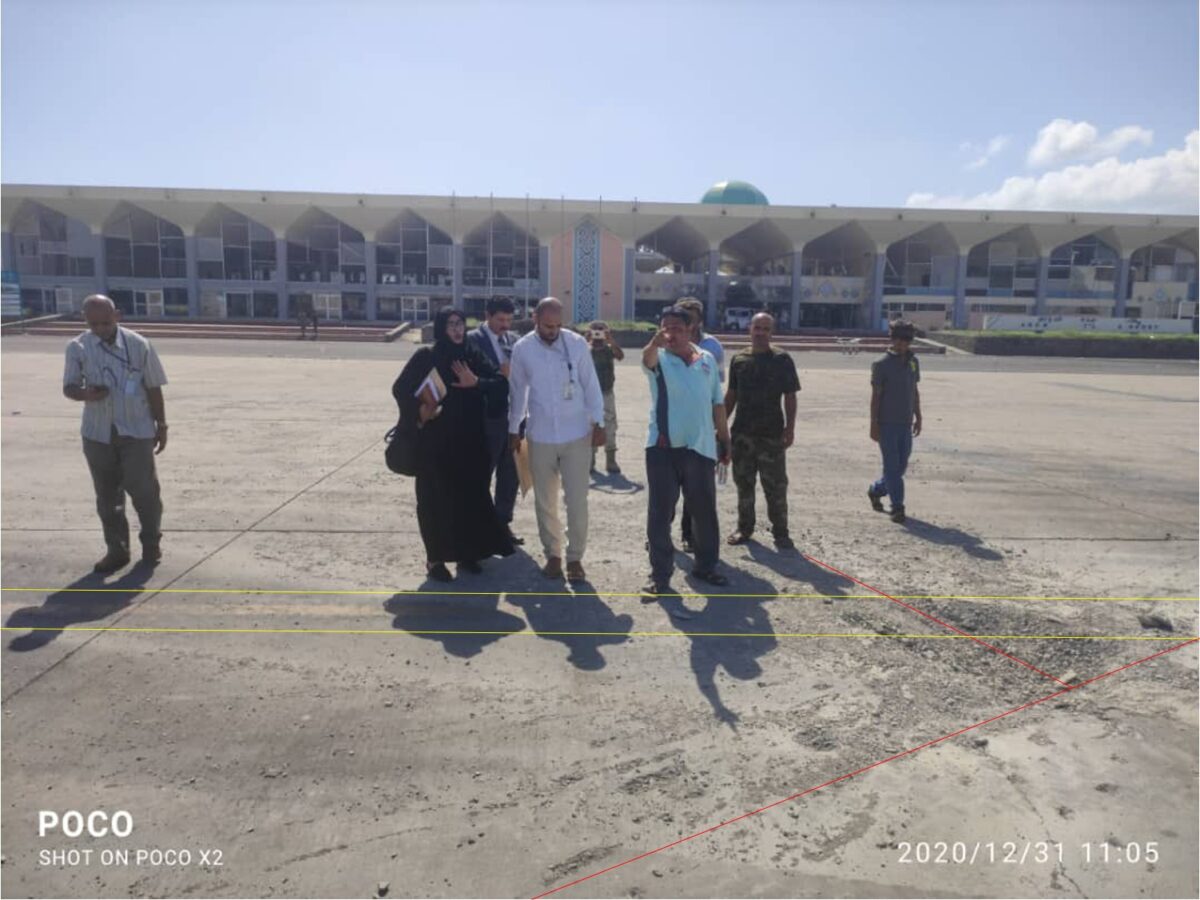
Image: Jouf Now. We have edited this image to highlight the direction of the yellow guiding line on the tarmac
The second impact point contains a crucial clue. As our previous investigations have demonstrated, craters can be used to identify the direction of origin of munitions. In this case the crater can be compared to the lines on the airport apron, which clearly indicate that the munition arrived from a north-westerly direction.
By manipulating the photo to appear as if we are viewing it from above, it can be established that the direction of origin lies very close to the city of Ta’izz, where, as we will see, there were multiple reports of rocket launches that day.
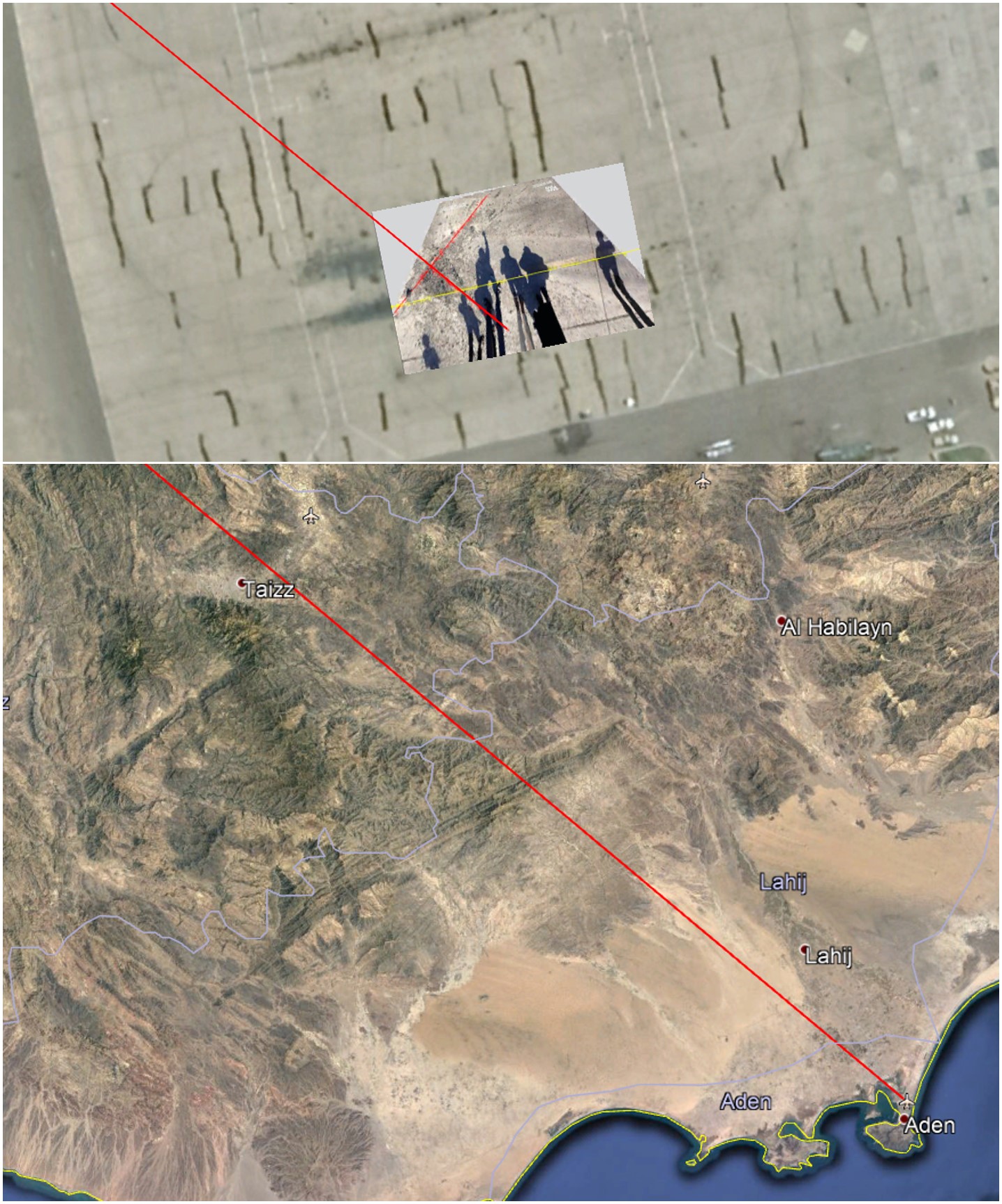
Direction of origin. Image: Google/Maxar Technologies. We have edited this image to indicate the direction of origin of the missile launch
At the time of the attack on Aden airport, Tai’zz and the surrounding region were largely under the control of Houthi militias.
The Munitions
There is less open source information about exactly what munitions were used. Fragments of these munitions were collected by the authorities and later displayed at a press conference on January 15, however, all of them were relatively small and there were no high-quality images of the fragments themselves. As such none were clear enough to be able to identify the exact munition.
Once again, the craters offer some clues. The location of the first impact, several metres up a wall below an overhanging roof, suggests that this was not a weapon with a high arc, such as a mortar. Individual frames in several videos caught at least one of these munitions immediately before impact. Although perspectives may be altered by the extremely short exposure, the munition appears to be the shape of a rocket rather than a mortar bomb or loitering munition. This would rule out use of the Qasef or Sammad, UAVs known to be used by the Houthi forces.
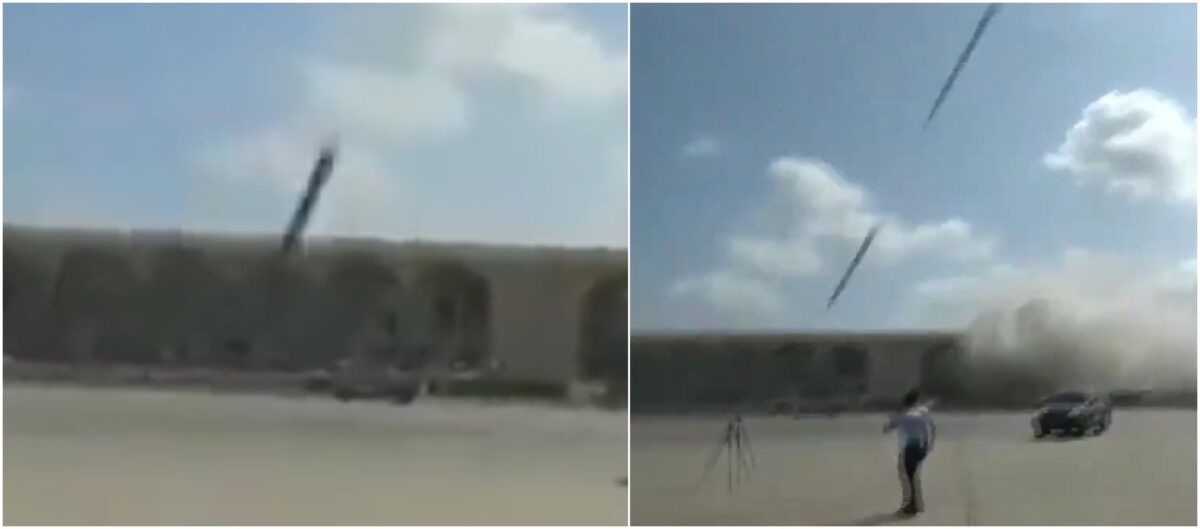
Missile Comparison. Left Image: Ali al-Sakani. Right Image: al-Arabiya
In the same press conference in which the munition fragments were displayed, stills from CCTV footage were shown, which also appeared to show some kind of rocket.
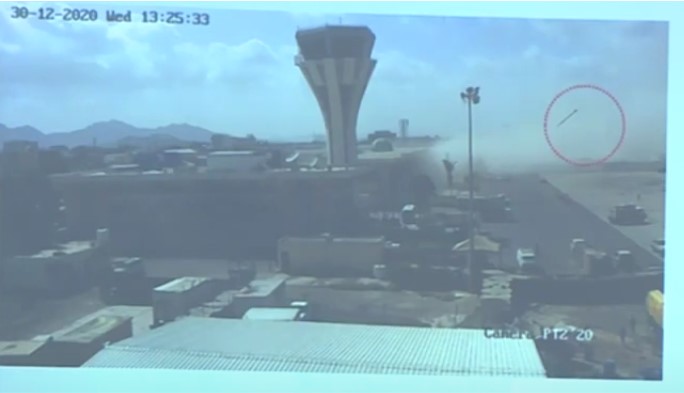
Image: Aden TV
The View from Ta’izz
On the same day as the attack in Aden, multiple videos were posted on social media appearing to show rockets being launched from Ta’izz and Dhamar, another city controlled by the Houthi movement.
We were able to geolocate four of these videos to Ta’izz, all of which show the same launch of two missiles, characterised by the distinctive flight of one of those missiles gyrating wildly before falling to earth.
- Video 1 can be geolocated to a village east of Ta’izz airport at 13.68878, 44.16130.
- Video 2 can be geolocated next to a road at 13.65393, 44.13682
- We were also able to geolocate Video 3 to near the entrance of Ta’izz airport. However, due to the video being filmed from the roof of what is likely a private dwelling, we have chosen not to identify the exact location so as not to endanger local residents. This video shows what appears to be the launch of at least one missile originating from within Ta’izz airport.
- Video 4 was filmed on the main road immediately outside Ta’izz airport, clearly showing that the missiles were either fired from within Ta’izz airport or its vicinity.
Multiple other images and videos of this launch which were posted on December 30, but it has not been not possible to geolocate them. All show what appear to be the same launch of two missiles, one of which falls in the distinctive manner described earlier.
That so many videos and images from Ta’izz, all showing the same rocket launch from multiple angles, were posted online the same day, along with testimony of this event taking place, strongly indicates that they were all indeed filmed on the same day: December 30.
We chronolocated these videos using the angles of the sun and the shadows it cast to establish a time window during which they were filmed. In order to mitigate the inaccuracy with this method we used multiple objects in each of the videos, establishing they were filmed not long after 13:00. It should be noted that there is a measure of inaccuracy to this method, and as such the timing is approximate.
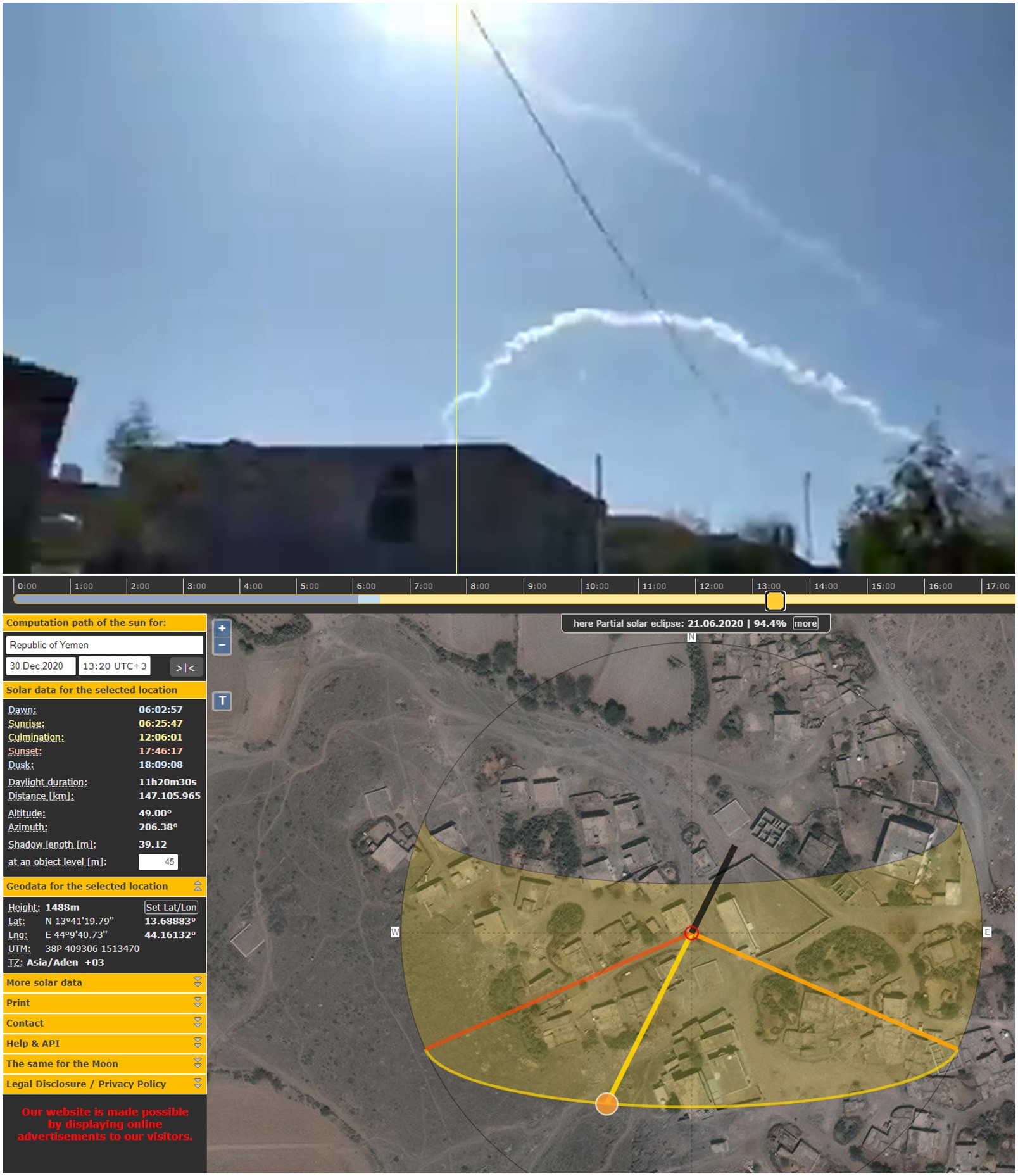
Example of a chronolocation using Video 1. Top Image: still from Video 1 (Ali al-Sakani), Bottom Image: SunCalc
A Failure?
All these videos indicate that the launch of at least one missile failed. The missile corkscrews through the sky and eventually falls to the ground. It is possible to use the intersection method to identify the area where this missile appears to have impacted, near a small factory a few kilometres South-East of Ta’izz airport.

Image: Google/Maxar Technologies. We have edited this image to demonstrate use of the intersection method
This is consistent with claims made on social media on December 30, citing Yemeni locals, that one missile had landed near a factory in the village of Al-Dahra. Yemen Archive identified a Facebook post with images of what appeared to be part of a relatively large missile with control-canards which was claimed to have been taken at the Al-Hashdi factory in the Al-Jund Valley.
Although it’s not possible to geolocate these images due to the lack of landscape detail, this is the same factory we identified as the impact point of the failed missile via intersection. Furthermore, at least one other social media post includes an image of the same fragment.

Image: Fouad Ali
It has not been possible to identify which type of munition this missile fragment originated from, as an examination of both Houthi and Iranian missiles did not produce any clear match. This is not unexpected, as Houthi munitions frequently differ from their display models due to mixed manufacturing techniques and materials.
The View from Dhamar
As well as the launches from Taiz, four videos discovered by our partners at the Yemeni Archive appear to show two successful launches from Dhamar. These videos all appear to show the same launch: a distinctive cloud, as well as the identical trail from the missile, can be seen in all four.

Left Image: Hussein Saran, Center Left Image: Hafiz Mutair, Center Right Image: Jaber Sheikh tribe, Right Image: Shoof Maeana
- Video 5 can be geolocated to 14.538085, 44.431170
- Video 6 can be geolocated to 14.514387, 44.409254
- Video 7 could not be precisely geolocated, although it certainly shows the Dhamar launches due to the presence of the same distinctive cloud and rocket trail.
- Video 8 was difficult to geolocate due to the low quality of the video, but the missile trail is certainly from the same launch as video 5, 6 and 7, placing it in Dhamar. The twin lamp post visible in the video indicates a road with two lanes with a central partition, and there appears to be a low building on the far side of the road, with two larger buildings in the background. The only place in Dhamar which fits all these features is 14.52950, 44.40263.

Left Image: Google/Maxar Technologies, Right Image: composite panorama of Video 8 (credit: Shoof Maeana)
Using the intersection method, it was possible to identify the vicinity from which these missiles were launched. This location is marked as a police training centre on Google Maps, which is consistent with multiple social media posts claiming that a missile launch occurred at a police base.
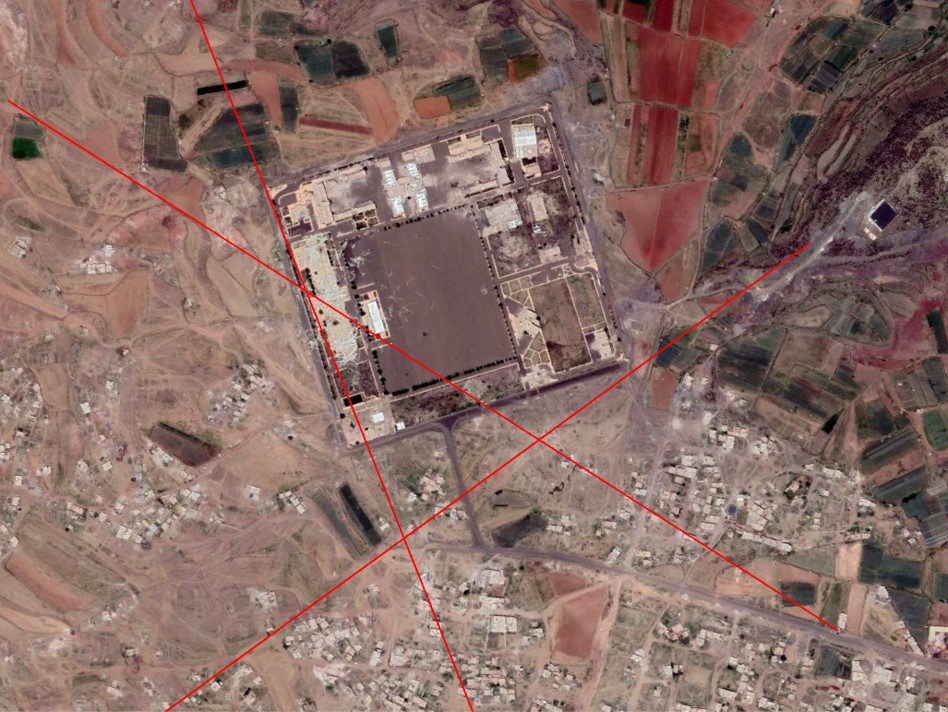
Image: Google/Maxar Technologies. We have edited this image to demonstrate use of the intersection method
Due to a lack of clear reference points in the Dhamar videos, the accuracy of the shadow analysis is significantly lower than for those taken in Ta’izz. However, the shadows in Video 5 appear to be perpendicular to the road, again indicating that the launch took place some time after 13:00.

Left Image: SunCalc, Right: Video 5 (credit: Hussein Saran)
A Houthi Hallmark
The open source evidence for the attack on Aden airport is substantial and significant. It shows that on December 30, shortly after 13:00, four missiles were launched from Houthi-controlled territory: two from the vicinity of Ta’izz airport and two from the vicinity of a police base in Dhamar. The launch of one of these missiles from Tai’zz was a failure; it corkscrewed to the ground and impacted a field a short distance away.
Although fragments apparently from this munition do not allow us to conclude much about its precise type, the size of the fragment, and the presence of control-canards, suggests a relatively large guided missile. It has been claimed by the Houthis that the Badr-1P ballistic missile, which could be a possible match, has a range of 150 km. This range would be enough to reach from Ta’izz to Aden, however Dhamar is almost 200km from Aden airport. It seems possible that the projectiles launched from Dhamar were either a different kind of missile, or a Badr-1P which may have been modified in some way.
What we can conclude is that at around 13:25, three large missiles impacted Aden airport within a minute of each other. The missile which landed on the airport apron certainly came from a North-Westerly direction, in the direction of Tai’zz. The other two missiles certainly came from a northerly direction, however, due to them impacting walls it is not possible to establish a more accurate direction of origin. One missile impacted the exact place where the plane carrying the newly agreed cabinet of Yemen would likely have been located, had it not changed bays at the last moment.
As such the available evidence indicates that, despite their denial, the Houthi movement were likely responsible for this attack. This continues a theme of the Houthi movement using effective intelligence and targeting of high-value targets to carry out long-range and accurate strikes, as previously seen in Aden, Al-Anad and Marib.
This investigation was carried out jointly with the Yemeni Archive

